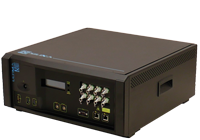for Active Distributed Temperature Sensing
Silixa’s Heat Pulse System (HPS) enables active distributed temperature sensing (A‑DTS) by applying heat pulses over time along a composite fibre optic cable at a constant power output per metre.
Active distributed temperature measurements provide information about thermal transport at all locations along a fibre optic cable. This insight can be crucial for monitoring fluid presence and flow in environments with limited natural thermal gradients, or for characterising thermal properties in-situ.

The system consists of:
- Silixa’s ULTIMA™ or XT-DTS™ distributed temperature sensor (DTS) to monitor the temperature response at all cable locations, continuously in time.
- Heat pulse control unit to generate heat pulses of desired power along hybrid/composite fibre optic cable in a controlled, flexible and safe manner.
- Control software to operate via a single interface both the heat pulse control unit and the DTS
- Interpretation software to perform basic processing of the DTS data collected during a heat pulse, in near real time.
- Hybrid/composite cable with optical fibre for temperature measurements and electrical conductors to enable heating
Heat pulse system integrates the heat pulse control unit with Silixa’s ULTIMA DTS or XT-DTS, control and interpretation software, and customised cable solutions to provide a complete A‑DTS monitoring solution.
A shared interface operates both the DTS and heat pulse control unit to provide precise and harmonised measurement control. The total measurement time, frequency, and intensity of the heating cycles can be set to meet the measurement requirements of the installation.
The A‑DTS monitoring solution delivers actionable information derived from continuous distributed temperature measurements that enable operators to manage and monitor water dependency and process challenges in compliance with Environmental, Social and Governance (ESG) business sustainability initiatives.

Active distributed temperature sensing is a powerful measurement method based on artificial thermal stimulation using heat pulse techniques to apply a known power input to a medium while monitoring the resultant thermal response.
The analyses of trends and absolute values of the temperature increase and subsequent decrease within a medium allows its thermal properties or related attributes and processes such as fluid presence and flow to be characterised in-situ. The method also has significant utility in environments where natural temperature gradients are not present.
The combination of active thermal response methods with distributed temperature (and strain or acoustic) sensors allows detailed characterisation of thermal attributes with high spatial density, over long distances.
The active distributed temperature sensing method has proven to be effective for a wide range of downhole, near surface, and atmospheric applications including:
- Determination of apparent thermal conductivity
- Geothermal reservoir characterisation
- Groundwater flow characterisation
- Identification of active fractures and flow features
- Mapping lithological variations
- Monitoring carbon sequestration
- Soil moisture distribution at high frequency and resolution
- Seepage through dams and levees
- Wind speed


The figure above shows an example of a thermal response to the heating and cooling phases of an A‑DTS test conducted in shallow borehole in fractured rock. The high spatial resolution of Silixa’s DTS allows identification of variations in temperature during heating and cooling at a sub-meter scale.
These differences can be caused by variations in the borehole lithology, porosity, or saturation with depth, or can be attributed to active fractures.
Profiles of apparent thermal conductivity can be calculated from the thermal response to an A‑DTS test, providing quantitative evaluation of variations in heat transport.














